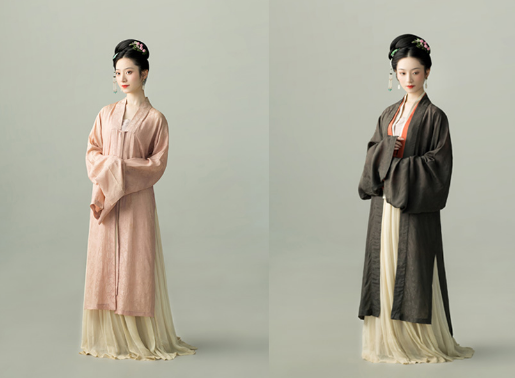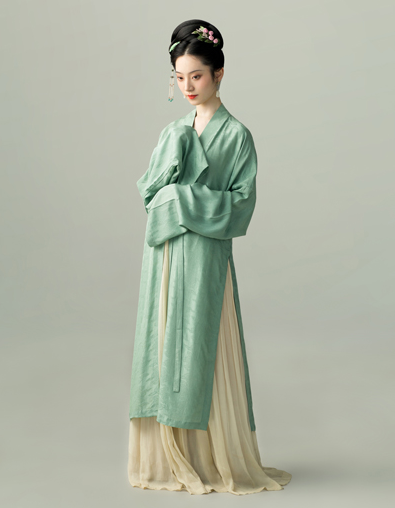Silk, especially charmeuse and brocade, are ideal for Song Dynasty Hanfu replicas.
Identifying Authentic Fabrics for Song Dynasty Hanfu
Traditional Textiles of the Song Dynasty
Exploring the vibrant world of Song Dynasty fashion unveils a remarkable array of textiles that shaped the Hanfu, the traditional Chinese attire. Silk reigned supreme in this era, a symbol of luxury and refinement. The Song Dynasty artisans mastered a plethora of silk-weaving techniques, producing a stunning variety of silks, from delicate damasks to opulent brocades. These fabrics transcended their utilitarian purpose, symbolizing status and elegance, particularly among the elite and royalty.
Alongside silk, ramie emerged as a significant textile, especially among the common people. Known for its strength and glossy finish, ramie offered an accessible alternative to silk. Despite its labor-intensive cultivation and processing, it gained popularity due to its breathability and ability to retain shape, making it ideal for everyday wear.

Fabric Analysis: Silk, Ramie, and Others
Analyzing these traditional fabrics, one can appreciate their unique characteristics that contribute to the authenticity of Hanfu garments. Silk, with its inherent sheen and smoothness, was the preferred choice for ceremonial and formal attire. Its capacity to hold vibrant dyes and intricate embroideries made it a perfect canvas for the era’s artistic expressions. The weaving patterns of silk, like jin (brocade) and qi (damask), are quintessential markers of the Song Dynasty’s aesthetic preferences.
In contrast, ramie presented a subtler elegance. Its natural white hue and slight gloss offered a less flamboyant yet graceful alternative to silk. Notably, the durability and longevity of ramie fabric were exceptional, often outliving its wearer, making it a practical choice for daily wear, particularly in China’s warmer southern regions.
Though less prominent, other fabrics like cotton and wool found their place in the Song Dynasty’s textile landscape. Cotton, introduced later during this period, was prized for its comfort and ease of maintenance. Wool, although not widely used due to China’s predominantly warm climate, served well in the colder northern regions for its insulating properties.
The Song Dynasty’s textile landscape presents a rich mosaic of materials, each with a specific role, reflecting the era’s social hierarchy and cultural values. The meticulous replication of these fabrics in modern Hanfu not only ensures historical accuracy but also preserves a crucial part of Chinese heritage. Integrating authentic materials like silk and ramie into contemporary Hanfu designs bridges the past and the present, offering wearers a tangible connection to history.
Best Fabrics for Replicating Song Dynasty Hanfu
Silk Varieties and Their Suitability
Delving into the realm of Song Dynasty Hanfu, the prominence of silk as the primary material is undeniable. This luxurious fabric, with its historical authenticity, comes in several varieties, each uniquely suited for different Hanfu styles.
Raw silk, or xiao, with its slightly coarse texture and robust nature, was the go-to choice for everyday attire. It offered durability and practicality, especially for the common folk. In contrast, charmeuse silk boasted a lustrous, smooth surface, perfect for the flowing robes of the elite. This type of silk symbolized status and grace, draping elegantly and highlighting the wearer’s sophistication.
For lighter, airy garments, chiffon silk stood out. Its sheer quality and delicate nature made it ideal for summer wear and complex Hanfu designs, where layering was essential. Satin silk, known for its glossy finish and luxurious feel, reserved its place for special occasions and ceremonial attire. This fabric epitomized sophistication and elegance, a true reflection of the Song Dynasty’s refined fashion sense.
Role of Brocade and Embroidery in Hanfu
When it comes to enriching Song Dynasty Hanfu with depth and opulence, brocade and embroidery play key roles. Brocade, a richly decorative woven fabric, often features raised designs and was a hallmark of high-end Hanfu. Craftsmen intricately wove this fabric, sometimes intertwining it with gold or silver threads, to create shimmering patterns. The artistry in brocade weaving was not just a skill but a revered art form, signifying wealth and prestige.
Embroidery, adding intricate detailing to Hanfu, transformed the garments into works of art. Embroiderers would skillfully sew designs onto the fabric, using silk thread and occasionally embellishing with pearls and precious stones. The motifs, often dragons, phoenixes, and floral patterns, were not mere decorations but held symbolic meanings. This meticulous art required skill and patience, making embroidered Hanfu a prized possession.
To replicate Song Dynasty Hanfu authentically, it’s essential to combine the right silk variety with appropriate brocade and embroidery techniques. Such an approach not only ensures visual authenticity but also pays homage to the cultural richness and craftsmanship of the era. By selecting the suitable fabrics and employing skilled craftsmanship, modern replicas can mirror the original elegance and beauty of the Song Dynasty Hanfu, thus keeping a significant part of Chinese textile history alive and relevant.
Comparing Fabric Qualities for Authentic Replication
Durability and Texture Comparison
In the meticulous process of replicating Song Dynasty Hanfu, understanding and comparing the durability and texture of different fabrics is crucial. Silk, often the first choice, is renowned not just for its smooth texture but also for its surprising resilience. Historically, silk garments have been known to last for centuries when properly maintained, a testament to their durability. Charmeuse silk, in particular, balances delicacy with strength, making it a preferred choice for garments that require a luxurious feel without compromising longevity.
Ramie, another traditional fabric, offers a different kind of durability. Its fibers are naturally strong and resistant to bacteria and mildews, which makes it incredibly long-lasting. The texture of ramie is unique – slightly coarse yet comfortable, and it becomes softer with each wash. This quality makes it ideal for everyday Hanfu that needs to withstand regular use.
Color and Pattern Authenticity in Fabrics
The authenticity of colors and patterns in fabrics plays a significant role in replicating Song Dynasty Hanfu. The era was known for its rich, vibrant colors, achieved through natural dyes derived from plants, minerals, and insects. Silk, with its high absorbency, captured these colors brilliantly, resulting in deep, lustrous hues that were a hallmark of Song Dynasty fashion. The challenge in modern replication lies in matching these colors, as many original dye sources are rare or have changed in composition over time.
Patterns in Song Dynasty fabrics were often intricate and symbolic. Brocade fabrics featured complex patterns woven into the fabric itself, often with gold or silver threads. The replication of these patterns requires not only the right materials but also skilled artisans who understand the traditional weaving techniques. Embroidery added another layer of pattern and color, often telling stories or conveying wishes for good fortune, prosperity, and health. Replicating these embroidered designs demands a deep understanding of the symbolism and styles of the period.
Replicating Song Dynasty Hanfu authentically involves a careful balance of selecting the right fabrics for durability and texture, as well as ensuring the authenticity of colors and patterns. By paying close attention to these details, modern recreations can capture the essence of the Song Dynasty’s rich textile heritage, bringing a piece of history to life.

Practical Tips for Choosing and Working with Hanfu Fabrics
Sourcing Authentic Replication Materials
For enthusiasts and professionals aiming to replicate Song Dynasty Hanfu, sourcing the right materials is a critical first step. Identifying suppliers who specialize in traditional fabrics like silk, ramie, and brocade is essential. These suppliers often have a deeper understanding of the qualities and historical context of these fabrics, ensuring a more authentic replication. It’s important to seek out suppliers who can provide fabrics that closely match the weight, texture, and weave of the original Song Dynasty textiles.
Networking with other Hanfu enthusiasts and joining communities, both online and offline, can be incredibly helpful. These groups often share valuable insights and resources, including information on where to find the best materials. For those looking to create truly authentic replicas, visiting traditional textile workshops or regions known for silk production can offer a unique opportunity to source materials directly from the artisans.
Handling and Maintenance of Traditional Fabrics
Working with traditional fabrics like silk and ramie requires a level of care and expertise to maintain their beauty and longevity. Handling these fabrics delicately during the sewing process is crucial, as they can be sensitive to tension and heat. Using the right needles and thread and adjusting sewing techniques to suit the fabric’s texture and weight can make a significant difference in the final outcome.
Maintenance of Hanfu garments is equally important. Silk, for instance, should be cleaned with care, preferably hand-washed or dry-cleaned to preserve its color and texture. Ramie, being more durable, can withstand gentle machine washing, but avoiding harsh detergents and excessive wringing is advisable to maintain its shape and finish.
Storing these garments correctly is also crucial for preserving their quality. They should be kept in a cool, dry place, away from direct sunlight, which can fade colors and weaken fibers. Using acid-free tissue paper to wrap the garments and storing them in breathable garment bags can help protect them from dust and moisture.
In conclusion, the process of replicating Song Dynasty Hanfu involves not just the selection of authentic fabrics but also the careful handling and maintenance of these materials. By paying close attention to these aspects, one can create and preserve Hanfu garments that not only look authentic but also stand the test of time, honoring the rich textile heritage of the Song Dynasty.